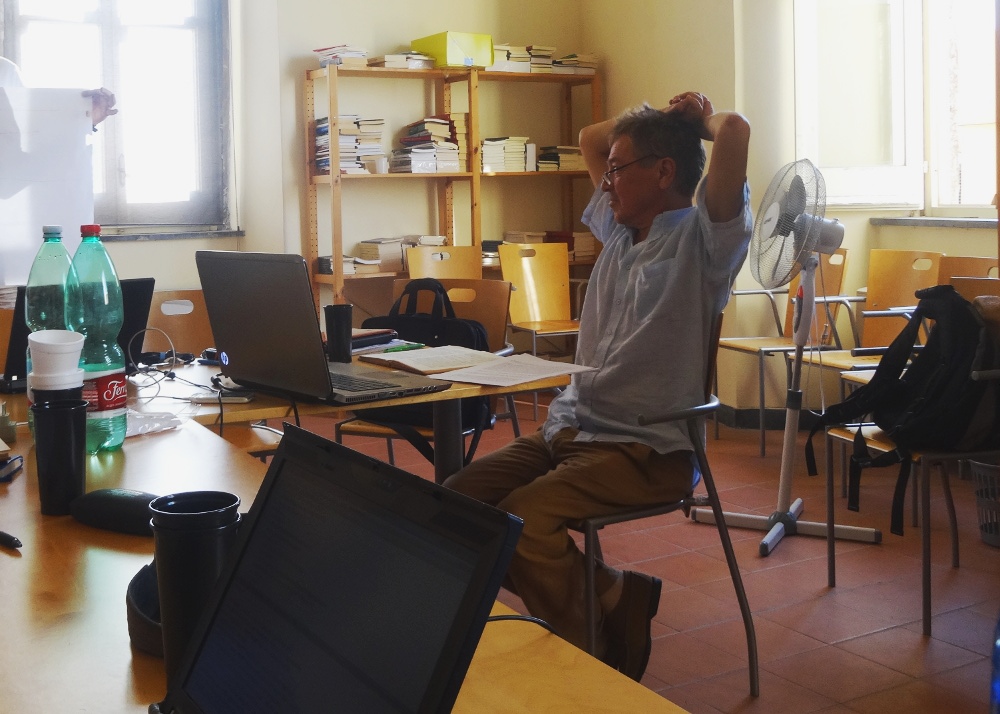The 175th Philosophers’ Carnival is ahead of schedule, here. It links to interesting posts, mostly on epistemology of testimony, philosophy of language, modal logic, ethics and theology, which are all more or less my favourite topics. Thus, I guess I should not complain about the lack of diversity in the posts mentioned.
Category Archives: epistemology
Arthāpatti and the Kevalavyatirekin anumāna
In the arthāpatti reading group we are currently reading the chapter on arthāpatti of Śālikanātha’s Prakaraṇapañcikā. As already discussed, Śālikanātha differentiates arthāpatti from anumāna insofar as in the latter the gamaka `trigger of the cognitive process’ is doubted, whereas, it is not so in the case of the anumāna, which can only start once the hetu ‘logical reason’ is certainly ascertained. At a certain point, however, Śālikanātha discusses whether the arthāpatti could not be understood as a kevalavyatirekin anumāna, an inference based only on negative concomitance.
Is there non-processed perception? The McGurk effect
The McGurk effect is a well-known experiment in which, while hearing a given phoneme and seeing someone pronouncing another phoneme, we “hear” the second one instead of the first one, the correct one. This seems to mean that the auditory perception of a phoneme is already processed, it is savikalpa. Try the McGurk effect in the following video:
Now, the problem is that, after many trials, this does not work with me. I guess that this might have to do with the fact that I am not an English Native speaker and that, accordingly, I process the image of someone pronouncing the second phoneme in a non-automatic way (after all, /f/ as pronounced in my native language is probably not pronounced with the same lip movement).
What do you think, does it work with you? If yes or if no, what is your native language
Arthāpatti (postulation? cogent evidence? derivation?) in Kumārila
Kumārila dedicated to arthāpatti eighty-eight verses in his Ślokavārttika (which is a commentary on the epistemological section of the Śābarabhāṣya). One would expect that also his Bṛhaṭṭīkā, which comments on the same text, contained a portion on arthāpatti and this is indirectly confirmed by further evidences:
- The verse said to be extracted from the Bṛhaṭṭīkā in the Mānameyoda‘s section on arthāpatti (discussed here)
- Four verses on arthāpatti attributed by Śālikanātha* to the Vārttikakāra (i.e., Kumārila) but not found in his Ślokavārttika
All these texts agree, among other things, on a major distinction between inference and arthāpatti, namely the fact that the vyāpti, the ‘invariable concomitance’ between what will be known and its logical reason, is already at the epistemic disposal of the knower before the anumāna, whereas in the case of the arthāpatti the knower, so to say, discovers it “on the go”, at the time of reaching the result of the arthāpatti. In other words, one would not have been able to say beforehand that there is an invariable concomitance between the set of people who, being alive, are not at home, and the set of people who are out of their home, until one had reached the conclusion that Devadatta must be outside.
For further details, see Yoshimizu 2007 (in Preisendanz (ed.) Expanding and Merging Horizons).
*I am obliged to Kiyotaka Yoshimizu who kindly alerted me to these verses.
Why are postulation (arthāpatti) and inference not the same thing?
Arthāpatti ‘postulation’ is the instrument of knowledge through which we know that Devadatta is out given that he is alive and not home. In Classical India, just like among contemporary scholars, several thinkers (especially of the Nyāya school) have tried to show that it is only a subset of inference.
Within the weekly reading group facilitated by Malcolm Keating, we are reading the section on arthāpatti of the Mānameyodaya by the Bhāṭṭa Mīmāṃsaka Nārāyaṇa Bhaṭṭa. This week, we read the part on the difference between inference and postulation according to the Prābhākaras.
Arthāpatti in the Mānameyodaya
The Mānameyodaya is the standard primer for Bhāṭṭa Mīmāṃsā epistemology. It is written in the clear style of other 17th c. primers and it is smooth and agreeable to read. These are just some of the reasons for choosing it for the first meeting of a virtual Sanskrit reading group initated by Malcolm Keating (see this post, which is also an open invitation for anyone to join). More in detail, we started reading the section on arthāpatti, which is an instrument of knowledge accepted by (Pūrva and Uttara) Mīmāṃsakas, but considered as a subset of inference by Naiyāyikas and other schools.
There is honey on the tree in your backyard; why are you going to the mountains in search of honey? The principle of parsimony in Mīmāṃsā
“If you can find honey on a tree nearby, why going to the mountains?”
arke cen madhu vindeta, kim artham parvataṃ vrajet
Veṅkaṭanātha’s epistemology, ontology and theology
In the world-view of a fundamental Viśiṣṭādvaita Vedānta teacher like Vedānta Deśika (1269–1370, aka Veṅkaṭanātha), theology is the center of the system and epistemology and ontology assume their role and significance only through their relationship with this center.
Helmut Krasser, the Rebel Sanskritist —UPDATED
I met Helmut Krasser during my Erasmus year in Vienna, back in the Nineties. We sat together (meaning that he, Horst Lasic and Ernst Steinkellner prepared and led the meetings whereas I and other people tried to follow and to add minor points from time to time) at the Academy, reading Jinendrabuddhi’s commentary on Dignāga’s Pramāṇasamuccaya.
What is unreal?
The term tuccha means in Classical Sanksrit “worthless”, “insignificant”. In Vedānta, however, it gets a more specific technical meaning, to denote the absolute unreality of chimeral entities, such as the khapuṣpa (flower in the air), which will not and cannot ever exist.

